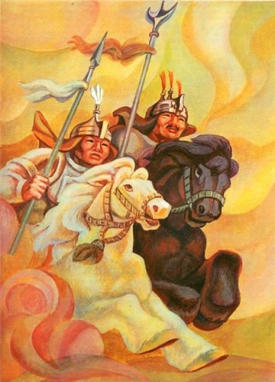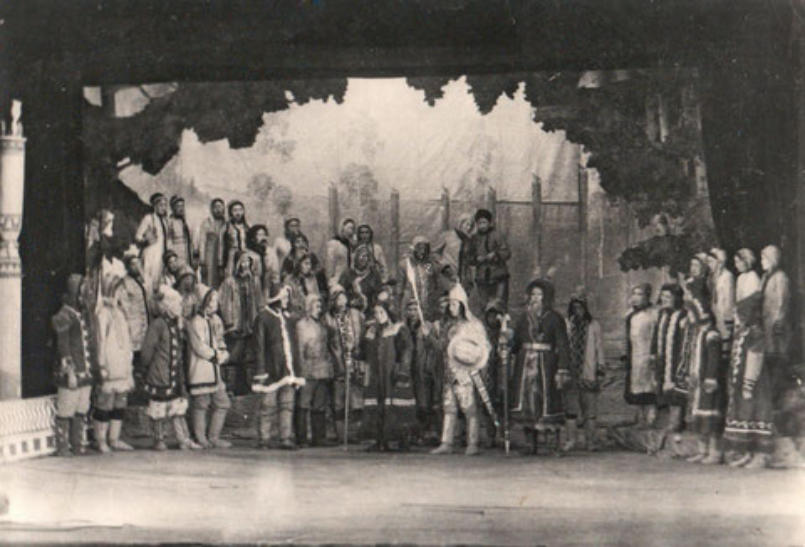Olonkho |
Yakut Heroic Epos | Oloncho | Olongkho



The
olonkho
is
a
heroic
epic
tale
of
the
Yakuts
and
one
of
the
oldest
epic
arts
of
the
Turkic
peoples.
The
term
refers
to
the
entire
Sakha
epic
tradition as well as its central epic.

The
olonkho
is
still
performed
in
the
Sakha
Republic.
The
poetic
tales
are
performed
by
a
singer
and
story-teller
in
two
parts:
a
sung
part
in
verse
alternates
with
a
prose
part
composed
of
recitatives.
In
addition
to
possessing
good
acting
and
singing
skills,
the
narrator
must
be
a
master
of
eloquence
and
poetic
improvisation.

The
epic
consists
of
numerous
legends
about
ancient
warriors,
deities,
spirits
and
animals,
but
also
addresses
contemporary
events,
such
as
the
disintegration
of
nomadic
socie.t

The
olonkhos,
varying
from
10,000
to
20,000
verses
(or
more)
in
length,
are
sung
during
a
period
of
up
to
seven
nights.
"Nyurgun
Bootur
the
Swift",
the
best-known,
consists
of
more
than 36,000 verses.

The
political
and
technological
changes
in
twentieth-century
Russia
have
threatened
the
existence
of
the
epic
tradition
in
the
Sakha
Republic.
Although
there
has
been
a
growing
interest
in
olonkho
since
the
perestroika
years,
this
tradition
is
endangered
because
of
the
very
low
number of practitioners.

Given
that
each
community
had
its
own
narrator
with
a
rich
repertoire,
numerous
versions
of
olonkho
circulated.
The
tradition
was
developed
within
the
family
context
for
entertainment
and
as
a
means
of
education.
Reflecting
Yakut
beliefs,
it
also
bears
witness
to
the
way
of
life
of
a
small
nation
struggling
for
survival
at
times
of
political
unrest
and
under
difficult
climatic
and
geographical conditions.

In
London,
published
Yakut
epic
olonkho
“
Nyurgun
Bootur
Swift
,
the
first
full
translation
into
English
olonkho.
I
am
confident
that
the
National
Day
Olonkho
will
further
the
conservation
of
the
world’s
cultural
heritage,
support
creative
and
humanitarian
initiatives,
strengthening
the
dialogue
among
civilizations.
I
wish
you
happiness,
health, luck and prosperity”.









Olonkho the Yakut Heroic Epos in Timofei Stepanovs three paintings | Music by Ayarkhaan
Als
eine
der
ältesten
epischen
Künste
der
türkischen
Völker
bezieht
sich
der
Begriff
Olonkho
auf
die
gesamte
epische
Tradition
der
Jakuten
sowie
auf
ihr
zentrales
Epos.
Heute
wird
er
übrigens
immer
noch
in
der
Republik
Sacha
im
äußersten
Osten
der
Russischen
Föderation aufgeführt.
Die
poetischen
Geschichten,
die
zwischen
10
und
15.000
Verse
lang
sind,
werden
vom
Olonkho-Sänger
und
Geschichtenerzähler
in
zwei
Teilen
aufgeführt:
Ein
gesungener
Teil
in
Versen
wechselt
mit
dem
prosaischen
Teil,
der
aus
Rezitativen
besteht.
Der
Erzähler
muss
nicht
nur
über
gute
Schauspiel-
und
Gesangsfähigkeiten
verfügen,
sondern
auch
ein
Meister
der
Beredsamkeit
und
der
poetischen
Improvisation
sein.
Das
Epos
besteht
aus
zahlreichen
Legenden
über
alte
Krieger,
Gottheiten,
Geister
und
Tiere,
befasst
sich
aber
auch mit zeitgenössischen Ereignissen wie dem Zerfall der Nomadengesellschaft.
Da
jede
Gemeinde
ihren
eigenen
Erzähler
mit
einem
reichen
Repertoire
hatte,
zirkulierten
zahlreiche
Versionen
von
Olonkho.
Die
Tradition
wurde
im
familiären
Kontext
zur
Unterhaltung
und
als
Bildungsmittel
entwickelt.
Es
spiegelt
die
Überzeugungen
der
Jakuten
wider
und
zeugt
auch
von
der
Lebensweise
einer
kleinen
Nation,
die
in
Zeiten
politischer
Unruhen
und
unter
schwierigen
klimatischen
und
geografischen
Bedingungen
ums
Überleben kämpft.
Die
politischen
und
technologischen
Veränderungen
im
Russland
des
20.
Jahrhunderts
haben
die
Existenz
der
epischen
Tradition
in
der
Republik
Sacha
bedroht.
Obwohl
seit
den
Perestroika-Jahren
ein
wachsendes
Interesse
an
Olonkho
besteht,
ist
diese
Tradition
angesichts der sehr geringen Zahl von Praktizierenden im gesamten Alter gefährdet.
Sacha-Jakutien > Olonkho | Titel > Olonkho | Index > Olonkho | 01




























